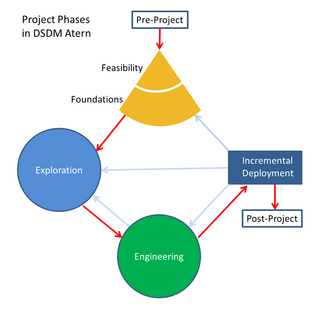Related Research Articles
Customer relationship management (CRM) is a process in which a business or another organization administers its interactions with customers, typically using data analysis to study large amounts of information.

Enterprise resource planning (ERP) is the integrated management of main business processes, often in real time and mediated by software and technology. ERP is usually referred to as a category of business management software—typically a suite of integrated applications—that an organization can use to collect, store, manage and interpret data from many business activities. ERP systems can be local-based or cloud-based. Cloud-based applications have grown in recent years due to the increased efficiencies arising from information being readily available from any location with Internet access.
A web portal is a specially designed website that brings information from diverse sources, like emails, online forums and search engines, together in a uniform way. Usually, each information source gets its dedicated area on the page for displaying information ; often, the user can configure which ones to display. Variants of portals include mashups and intranet dashboards for executives and managers. The extent to which content is displayed in a "uniform way" may depend on the intended user and the intended purpose, as well as the diversity of the content. Very often design emphasis is on a certain "metaphor" for configuring and customizing the presentation of the content and the chosen implementation framework or code libraries. In addition, the role of the user in an organization may determine which content can be added to the portal or deleted from the portal configuration.
An extranet is a controlled private computer network that allows communication with business partners, vendors and suppliers or an authorized set of customers. It extends intranet to trusted outsiders. It provides access to needed services for authorized parties, without granting access to an organization's entire network. It can be implemented securely, either with dedicated links or as a VPN.
In the United States, federal grants are economic aid issued by the United States government out of the general federal revenue. A federal grant is an award of financial assistance from a federal agency to a recipient to carry out a public purpose of support or stimulation authorized by a law of the United States.

Dynamic systems development method (DSDM) is an agile project delivery framework, initially used as a software development method. First released in 1994, DSDM originally sought to provide some discipline to the rapid application development (RAD) method. In later versions the DSDM Agile Project Framework was revised and became a generic approach to project management and solution delivery rather than being focused specifically on software development and code creation and could be used for non-IT projects. The DSDM Agile Project Framework covers a wide range of activities across the whole project lifecycle and includes strong foundations and governance, which set it apart from some other Agile methods. The DSDM Agile Project Framework is an iterative and incremental approach that embraces principles of Agile development, including continuous user/customer involvement.
A dedicated hosting service, dedicated server, or managed hosting service is a type of Internet hosting in which the client leases an entire server not shared with anyone else. This is more flexible than shared hosting, as organizations have full control over the server(s), including choice of operating system, hardware, etc.
Web-to-print, also known as Web2Print, remote publishing or print e-commerce is commercial printing using web sites. Companies and software solutions that deal in web-to-print use standard e-commerce and online services like hosting, website design, and cross-media marketing.
Traction TeamPage is a proprietary enterprise 2.0 social software product developed by Traction Software Inc. of Providence, Rhode Island.
Software asset management (SAM) is a business practice that involves managing and optimizing the purchase, deployment, maintenance, utilization, and disposal of software applications within an organization. According to ITIL, SAM is defined as “…all of the infrastructure and processes necessary for the effective management, control, and protection of the software assets…throughout all stages of their lifecycle.” Fundamentally intended to be part of an organization's information technology business strategy, the goals of SAM are to reduce information technology (IT) costs and limit business and legal risk related to the ownership and use of software, while maximizing IT responsiveness and end-user productivity. SAM is particularly important for large corporations regarding redistribution of licenses and managing legal risks associated with software ownership and expiration. SAM technologies track license expiration, thus allowing the company to function ethically and within software compliance regulations. This can be important for both eliminating legal costs associated with license agreement violations and as part of a company's reputation management strategy. Both are important forms of risk management and are critical for large corporations' long-term business strategies.
Presales is a process or a set of activities/sales normally carried out before a customer is acquired, though sometimes presales also extends into the period the product or service is delivered to the customer.
Knowledge Discovery Metamodel (KDM) is a publicly available specification from the Object Management Group (OMG). KDM is a common intermediate representation for existing software systems and their operating environments, that defines common metadata required for deep semantic integration of Application Lifecycle Management tools. KDM was designed as the OMG's foundation for software modernization, IT portfolio management and software assurance. KDM uses OMG's Meta-Object Facility to define an XMI interchange format between tools that work with existing software as well as an abstract interface (API) for the next-generation assurance and modernization tools. KDM standardizes existing approaches to knowledge discovery in software engineering artifacts, also known as software mining.
A vendor management system (VMS) is an Internet-enabled, often Web-based application that acts as a mechanism for business to manage and procure staffing services – temporary, and, in some cases, permanent placement services – as well as outside contract or contingent labor. Typical features of a VMS application include order distribution, consolidated billing and significant enhancements in reporting capability that outperforms manual systems and processes.
Anti-money laundering (AML) software is software used in the finance and legal industries to help companies comply with the legal requirements for financial institutions and other regulated entities to prevent or report money laundering activities. AML software can facilitate faster and more accurate compliance and investigations.
Unified communications (UC) is a business and marketing concept describing the integration of enterprise communication services such as instant messaging (chat), presence information, voice, mobility features, audio, web & video conferencing, fixed-mobile convergence (FMC), desktop sharing, data sharing, call control and speech recognition with non-real-time communication services such as unified messaging. UC is not necessarily a single product, but a set of products that provides a consistent unified user interface and user experience across multiple devices and media types.
Platform as a service (PaaS) or application platform as a service (aPaaS) or platform-based service is a cloud computing service model where users provision, instantiate, run and manage a modular bundle of a computing platform and applications, without the complexity of building and maintaining the infrastructure associated with developing and launching application(s), and to allow developers to create, develop, and package such software bundles.
Jeff Lawrence is an American entrepreneur, technologist and philanthropist. He founded and ran a number telecommunications systems companies. He sold one of his business to Intel in 2000 and worked for Intel until 2002. As a result, together with his wife he founded The Lawrence Foundation giving out grants to non-profit environmental, human services, and other causes.
Network functions virtualization (NFV) is a network architecture concept that leverages IT virtualization technologies to virtualize entire classes of network node functions into building blocks that may connect, or chain together, to create and deliver communication services.

Xait is a software development company, specializing in Web-based database services. The company provides its customers with software for document publishing and collaboration. Its product, XaitPorter, is a collaborative-writing software and is used by clients worldwide to create bids, proposals, financial reports, contracts and other business critical documentation. In Norway, the majority of all Oil operators use XaitPorter for writing their drilling license applications. At the 22nd licensing round in Norway, 100% of the oil & gas operator licenses on Norwegian continental shelf were awarded to XaitPorter clients. The company has been ISO/IEC 27001 certified since 2016, and has since received re-certification the following years.

VOSS Solutions is a British-founded multinational provider of digital workplace management technology, headquartered in Garland, Texas, that provides automation management software.
References
- ↑ "Archived copy". Archived from the original on 2011-05-18. Retrieved 2011-06-03.
{{cite web}}: CS1 maint: archived copy as title (link) - ↑ "Office of Foreign Assets Control (OFAC)". Treasury.gov. 2012-04-09. Retrieved 2012-05-22.
- ↑ "Pre Award Management". Grants.gov, National Institutes of Health. 2010-10-20. Retrieved 2012-09-20.
- ↑ "Post Award Management". Grants.gov, National Institutes of Health. 2010-10-20. Retrieved 2012-09-20.
- ↑ "The Truth About Hosted Software Packages". Idealware. 2010-06-15. Archived from the original on 2012-05-12. Retrieved 2012-05-22.
- ↑ "InfoReady Helps Customers Navigate $1 Trillion Grant Market With Search and Collaboration Software". Xconomy. 2010-11-04. Retrieved 2012-05-22.
- ↑ "Eagle Eye Publishers | Bloomberg Government". Usaspending.org. Archived from the original on 2011-06-26. Retrieved 2012-05-22.
- ↑ "Home". Grants.gov. 2012-03-19. Retrieved 2012-05-22.
- ↑ "Bill & Melinda Gates Foundation, Ford Foundation & Other Top U.S. Foundations". Foundation Center. Archived from the original on 2015-11-13. Retrieved 2012-05-22.
- ↑ http://www.uams.edu/postdocsociety/grantsmanship_workshop_files/Tips%20for%20Applying%20to%20Private%20Foundations%20for%20Grant%20Money.pdf [ bare URL PDF ]
- ↑ "Archived copy" (PDF). Archived from the original (PDF) on 2011-10-05. Retrieved 2011-06-03.
{{cite web}}: CS1 maint: archived copy as title (link) - ↑ "Become an eGrant Reporter". Foundation Center. Retrieved 2012-05-22.